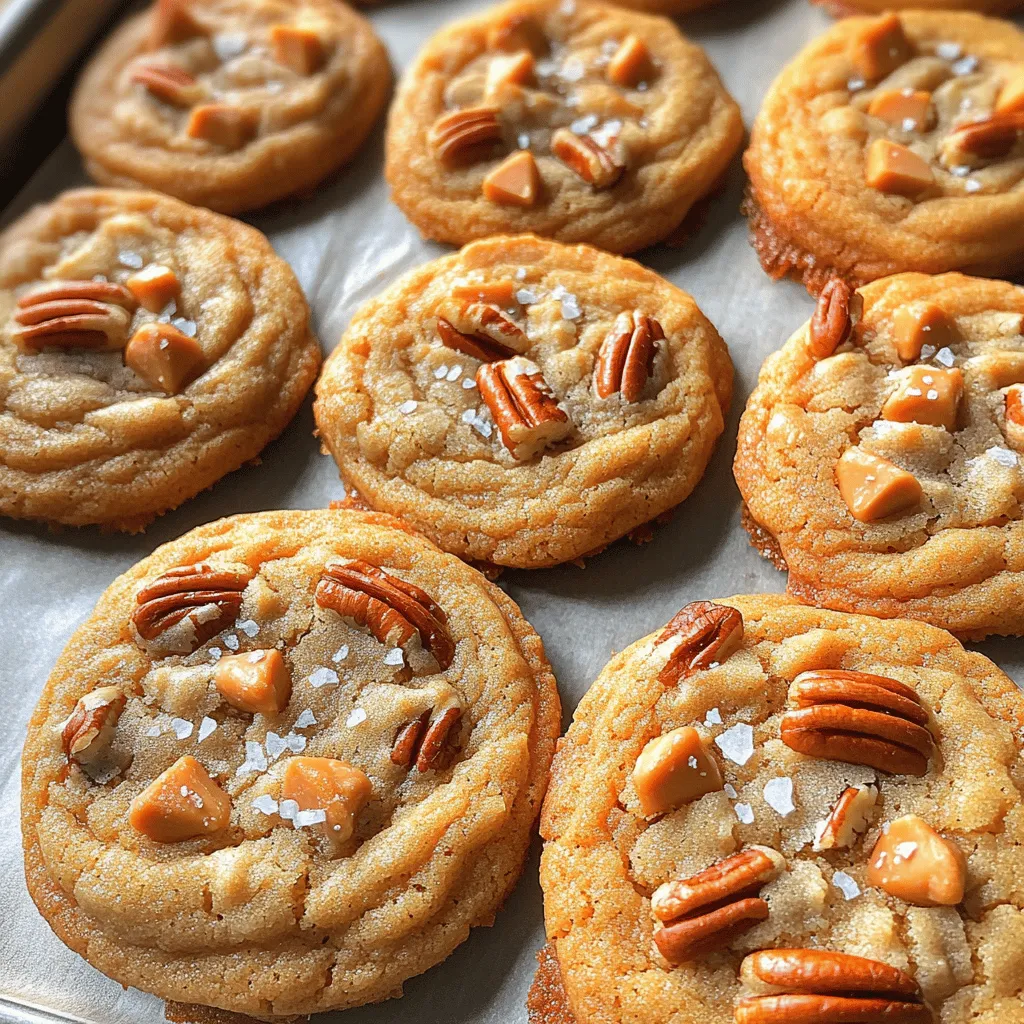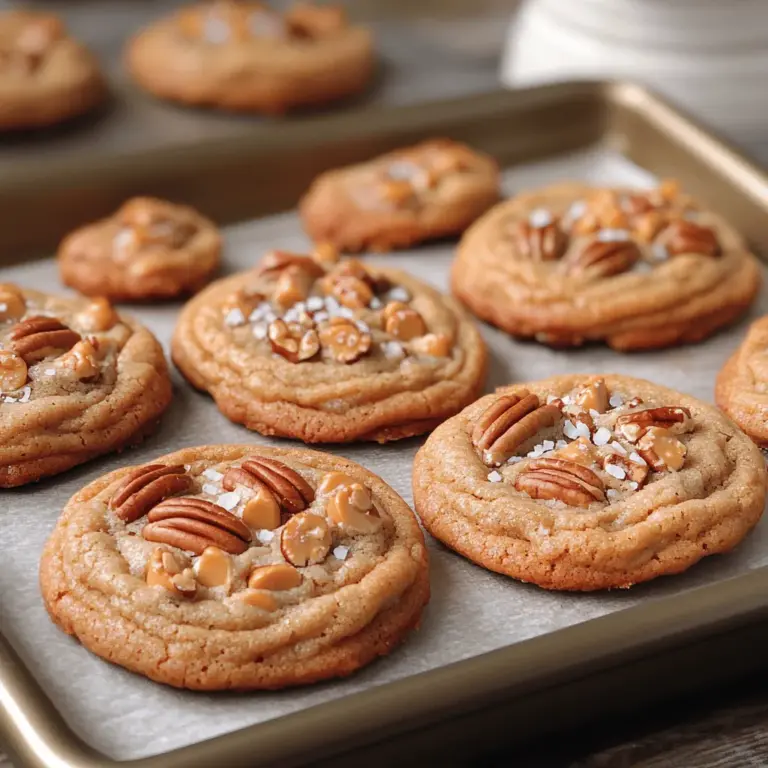Introduction
Cookies hold a special place in the hearts of dessert lovers around the world. Their universal appeal transcends age, culture, and occasion. Whether it’s the comforting aroma wafting from a warm batch in the oven or the moment of pure bliss when biting into a freshly baked treat, cookies evoke feelings of nostalgia and joy. Among the vast array of cookie flavors, salted butterscotch cookies stand out as a delightful fusion of sweet and salty, creating a taste sensation that captivates the palate.
Salted butterscotch cookies are an indulgent treat that combines the rich, buttery flavor of butterscotch with the satisfying crunch of a perfectly baked cookie. What makes these cookies truly special is their ability to balance sweetness with a hint of salt, elevating each bite to a new level of deliciousness. The texture is equally appealing: soft and chewy on the inside with a slightly crispy exterior, making them irresistible to cookie enthusiasts.
In this article, we will delve into the unique attributes of salted butterscotch cookies, exploring their delightful flavors, textures, and the sheer joy they bring to any gathering or quiet evening at home. We will guide you through the recipe, ensuring that you can recreate these sweet treats in your own kitchen.
Understanding the Ingredients
Baking is both an art and a science, and the ingredients you choose play a crucial role in determining the success of your salted butterscotch cookies. Let’s break down the essential components of this delightful recipe to understand how they contribute to the final product.
The Base: Butter and Sugars
At the heart of every great cookie recipe is the combination of butter and sugars. For our salted butterscotch cookies, unsalted butter is the star player. Using unsalted butter allows for better control over the seasoning, giving you the freedom to add the perfect amount of salt to taste. The butter provides moisture and richness, contributing to the cookies’ soft, chewy texture.
When it comes to sugars, we will use both brown sugar and granulated sugar. Brown sugar, with its molasses content, adds depth of flavor and moisture to the cookies, resulting in a rich, caramel-like taste. Granulated sugar, on the other hand, helps the cookies spread and gives them a lovely crispness around the edges. This combination of sugars creates a well-rounded sweetness that perfectly complements the butterscotch flavor.
Binding Agents: Eggs and Vanilla
Eggs are essential in cookie recipes as they provide structure and richness. In our salted butterscotch cookies, one large egg will do the trick, offering the necessary binding to hold the ingredients together while also adding moisture. The richness of the egg yolk enhances the overall flavor, contributing to a soft and tender crumb.
Vanilla extract is another key ingredient that elevates the flavor profile of the cookies. A splash of pure vanilla extract not only adds aromatic sweetness but also enhances the taste of the butterscotch and other ingredients, making each bite more delightful. It’s a small addition that makes a significant impact on the overall flavor experience.
Dry Ingredients: Flour, Baking Soda, and Sea Salt
The foundation of any cookie recipe lies in the dry ingredients, and for our salted butterscotch cookies, we will primarily use all-purpose flour. This versatile flour provides the structure necessary for the cookies to hold their shape while allowing for a soft and chewy interior. Sifting the flour before measuring can help prevent clumps and ensure even distribution throughout the dough.
Baking soda acts as a leavening agent, helping the cookies rise and achieve that desirable chewy texture. It also contributes to the browning of the cookies, enhancing their flavor. Finally, a sprinkle of sea salt is crucial in this recipe; it not only balances the sweetness of the butterscotch but also amplifies the overall flavor, creating that addictive sweet-and-salty contrast that makes these cookies so irresistible.
Add-ins: Butterscotch Chips and Pecans
No salted butterscotch cookie would be complete without the star ingredient: butterscotch chips. These creamy, melt-in-your-mouth chips infuse the cookies with the signature butterscotch flavor, reminiscent of caramel and toffee. Their sweet richness is the perfect complement to the slight saltiness, making each bite a delightful experience.
For those who enjoy a bit of texture, optional pecans can be added to the cookie dough. Chopped pecans provide a nutty flavor and a satisfying crunch, enhancing the overall experience of the cookies. If you’re a fan of nuts, feel free to experiment with other varieties like walnuts or even macadamia nuts for a personalized touch.
Step-by-Step Guide to Making Salted Butterscotch Cookies
Now that we’ve covered the essential ingredients, let’s dive into the step-by-step process of making these delectable salted butterscotch cookies. Following these instructions will ensure a smooth baking experience and a delicious outcome.
Prepping Your Workspace
Before you begin baking, it’s important to prepare your workspace. A well-organized kitchen will make the process efficient and enjoyable.
1. Gather Your Ingredients: Ensure all your ingredients are at room temperature for optimal mixing. This includes your unsalted butter, eggs, and vanilla extract. Having everything ready at hand will streamline the process.
2. Equipment Essentials: You will need a mixing bowl, a whisk or electric mixer, a spatula, measuring cups and spoons, and a baking sheet lined with parchment paper. Preheating your oven to 350°F (175°C) at this stage will also help save time later on.
3. Clean and Clear: Clear your countertops of any clutter to create a dedicated space for mixing and baking. This will help you keep track of your ingredients and tools, making it easier to focus on creating those delicious cookies.
Mixing Techniques for Perfect Cookies
The mixing process is critical to achieving the right texture in your salted butterscotch cookies. Follow these detailed instructions for the best results:
1. Creaming Butter and Sugars: In a mixing bowl, add your softened unsalted butter, brown sugar, and granulated sugar. Using a whisk or an electric mixer, cream the butter and sugars together until the mixture is light and fluffy. This process incorporates air into the mixture, which is essential for a tender cookie.
2. Adding Eggs and Vanilla: Once your butter and sugars are well combined, add in the egg and vanilla extract. Mix until fully incorporated, ensuring that the egg is evenly distributed throughout the batter. This step is vital for achieving a uniform texture in your cookies.
3. Combining Dry and Wet Ingredients: In a separate bowl, whisk together your all-purpose flour, baking soda, and sea salt. Gradually add the dry ingredients to the wet mixture, mixing until just combined. Be careful not to over-mix, as this can lead to tougher cookies. The goal is to have a smooth dough with no visible flour.
As you combine the ingredients, you will begin to see the dough take shape. This is where the magic happens, and the anticipation of enjoying those salted butterscotch cookies builds.
Stay tuned for the rest of the recipe, where we will explore the final steps that will lead you to a batch of irresistibly delicious salted butterscotch cookies. The journey of baking these cookies is not just about the end result; it’s about the joy of creating something delightful that you can share with friends and family. Happy baking!

Best Practices for Incorporating Dry Ingredients
When it comes to baking cookies, the way you incorporate dry ingredients plays a crucial role in achieving the perfect texture. For your salted butterscotch cookies, it’s essential to sift together your dry ingredients: flour, baking soda, and salt. Sifting aerates the flour, allowing it to blend more evenly with the other ingredients and preventing clumps.
To maintain the ideal cookie texture, start by adding the dry mixture to the wet ingredients in batches. This helps to ensure that everything is well combined without overworking the dough. Gently fold the dry ingredients into the wet mixture using a spatula. This method preserves the airiness of the dough, creating chewy cookies rather than dense ones.
Tips on Avoiding Overmixing
One of the most common pitfalls in baking cookies is overmixing the dough. When you mix the dough too vigorously or for too long, you develop gluten, which can lead to tough cookies. To avoid this, mix just until the flour is incorporated. It’s okay if there are a few streaks of flour remaining; you can fold them in gently with a spatula. This ensures that your cookies will be tender and soft, with that delightful chewy texture we all love.
Incorporating Butterscotch and Pecans
Once your dough is well mixed, it’s time to fold in the star ingredients—both butterscotch chips and toasted pecans. To achieve even distribution throughout the dough, sprinkle the butterscotch chips and pecans over the surface of the dough rather than dumping them all in at once. Using a spatula, gently fold the ingredients in with a few strokes, being careful not to overmix. This technique ensures that each cookie will have a perfect balance of flavors, with each bite containing both sweet butterscotch and crunchy pecans.
Shaping and Preparing for Baking
When shaping your cookies, it’s important to use the right portion size to ensure even baking. A standard cookie scoop or tablespoon works well for measuring out the dough. Aim for 1.5 tablespoons of dough per cookie.
After portioning the dough, roll each scoop into a ball and place them on a baking sheet lined with parchment paper. Make sure to leave enough space between each cookie—about two inches apart—since they will spread as they bake.
Before placing the cookies in the oven, don’t forget the finishing touch: a sprinkle of flaky sea salt. This step enhances the flavor profile, allowing the sweetness of the butterscotch to shine while providing a delightful contrast.
Baking Tips for the Perfect Cookie
For the best results, preheat your oven to 350°F (175°C). This temperature allows the cookies to bake evenly, resulting in a golden-brown exterior while keeping the center soft and chewy. Bake your cookies for about 10-12 minutes, but keep a close eye on them towards the end. The cookies are typically done when the edges are slightly firm but the centers appear soft and underbaked. They will continue to set as they cool on the baking sheet.
Once your cookies are out of the oven, resist the urge to dig in immediately! Cooling time is essential for proper texture development. Allow the cookies to cool on the baking sheet for at least 5 minutes before transferring them to a wire rack. This cooling period helps the cookies firm up and enhances the chewy texture.
Flavor Profile and Texture Analysis
Sweetness vs. Saltiness
One of the defining characteristics of salted butterscotch cookies is their unique flavor profile, which harmoniously balances sweetness and saltiness. The rich, buttery sweetness of the butterscotch chips provides a decadent base, while the sprinkle of sea salt elevates the flavor, creating a mouthwatering contrast. This balance not only satisfies the sweet tooth but also keeps the flavor from becoming overly saccharine, making each bite an experience of contrast and depth.
Texture Breakdown
The texture of these salted butterscotch cookies is another aspect that makes them so irresistible. Each cookie boasts a chewy center that is moist and flavorful, thanks to the buttery dough and the richness of the butterscotch. The edges, on the other hand, are slightly crisp, creating a delightful contrast in every bite. This combination of textures—from chewy to crispy—adds to the overall enjoyment of the cookie, making them a perfect treat for any occasion.
Serving Suggestions and Pairings
Best Ways to Serve Salted Butterscotch Cookies
These decadent cookies are best enjoyed warm, right out of the oven, when the butterscotch is gooey and melty. However, they are equally delightful at room temperature, allowing the flavors to develop even further. You can serve them on their own or pair them with a scoop of vanilla ice cream for an indulgent dessert.
Recommendations for Beverages
When it comes to pairing beverages with salted butterscotch cookies, you have several excellent options. A cup of freshly brewed coffee complements the sweetness of the cookies beautifully, enhancing the overall flavor experience. Alternatively, a glass of cold milk is a classic pairing that appeals to both kids and adults alike. For a more adventurous twist, consider serving these cookies with a rich hot chocolate or a glass of dessert wine.
Storing Your Cookies
To keep your salted butterscotch cookies fresh, store them in an airtight container at room temperature. This will help retain their chewiness and prevent them from becoming stale. If you want to keep them for an extended period, consider freezing them. Allow the cookies to cool completely, then place them in a freezer-safe bag or container. They can be frozen for up to three months. When you’re ready to enjoy them, simply thaw at room temperature or warm them slightly in the oven for that freshly baked taste.
Conclusion
Salted butterscotch cookies are a delightful treat that brings joy to any occasion, whether it’s a casual snack or a special celebration. The perfect balance of sweet and salty flavors, combined with a delightful texture, makes these cookies a favorite among both children and adults.
We encourage you to try this recipe and share the experience with family and friends. Baking these cookies is not just about satisfying a craving; it’s about creating memories in the kitchen that last a lifetime. The versatility of cookies allows for endless variations, so feel free to experiment with different add-ins or toppings to make this recipe your own. Enjoy the process of baking, and relish the delicious results!

